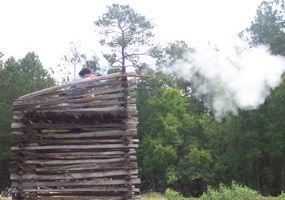
Ninety Six National Historic Site Date: April 23, 2006 When you look around Ninety Six, the Star symbol is everywhere. But how many people know the history of Ninety Six’s famous Star Fort? In December 1780 the Loyalists started building the Star Fort, but it was not finished until early 1781. A Star design for a fort was not popular, it was hard to build, and it could not hold many troops. But British engineer Lt Henry Haldane decided that an 8 point Star fort would be better for the site than a tradition square fort. During the Siege of Ninety Six May 22-June 18, 1781, the Star Fort was 14 feet high. When you visit the Park today you see the original Star Fort. It’s a little weather worn but it hasn’t been reconstructed or altered in any way. So just what is a sapper? When the Patriots arrived the Loyalists held the Star Fort, the town of Ninety Six, and the Stockade Fort. The Patriot chief engineer Thaddeus Kosciuszko viewed the situation and he believed that the Star Fort was the strongest Loyalist held position and that if it fell so would the town and Stockade Fort. General Nathaniel Greene agreed and the Patriots began siege operations. They began digging approach trenches or saps. A sap would be dug at an angle or zig-zag to the Star Fort so that the Loyalists could not fire into them. The sappers built parallels which paralleled the Star Fort and saps that were at angles as they made their way toward the Star Fort. Archeological digs in the 1970s found the location of the Patriot saps and trenches. They were originally 4 to 7 feet wide and 2 to 3 feet deep. The 1s approach trench was started as soon as the Patriots arrived and was completed May 27. The 3rd and last parallel was completed June 10. The Patriots used gabions and fascines to make the saps higher and safer. Gabions were baskets filled with dirt made from vines and twigs. Fascines were bundles of branches that were 5 to 12 feet long and tied together. The Gabions and fascines on the saps allowed the Patriots to stand up and pass supplies along the trenches. When you visit the park today you can see the reconstructed saps and trenches. Another tactic that the Patriots tried was to build a mine. From the 3rd parallel they dug down 6 feet then started digging toward the Star Fort. The idea was to dig the mine under the Star fort, pack it with gunpowder, and blow a hole in the Star’s walls to allow the Patriots to attack inside. The mine was not completed and still exists today. It is sealed off to preserve it, but the park has pictures from inside where you can still see shovel and picks marks that were made 225th years ago. During the Park’s 225th anniversary, May 20-21, 2006, there will be several events taking place where you can learn more and see sappers and miners actually making gabions, fascines, and talking about 18th century military engineering.
To read more about the special places of Ninety Six National Historic Site, see our Places section. |
Last updated: April 14, 2015
